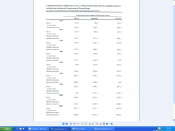Economics Department
Output and Gender Discrimination in Pay:
Evidence from Manufacturing Industry of the Kyrgyz Republic
Student Name: Aisalkyn Alimbaeva
December 2008
Output and Gender Discrimination in Pay:
Evidence from Manufacturing Industry of the Kyrgyz Republic
Abstract
Using linear regression analysis and time-series data, this research paper investigates whether gender discrimination in pay negatively affects output. The results showed high statistical significance and anticipated outcome. As stated in economic theory and proved in the majority of the literature discussed, evidence from manufacturing industry of the Kyrgyz Republic (years 1999-2007) demonstrated a negative relationship between gender pay gap and output, when control for gender gap in employment. With existing data and econometric knowledge, results of the regression indicate that a 1% decrease in gender wage gap leads to 0.76 % increase in output. Thus, the null hypothesis cannot be rejected.
Keywords: output, gender, discrimination in pay, manufacturing industry, the Kyrgyz Republic
JEL Classification: E23, J16, L60
C o n t e n t s
I. Introductionâ¦â¦â¦â¦â¦â¦â¦â¦â¦â¦â¦â¦â¦â¦â¦â¦â¦â¦â¦...............................................4
II. Theoretical Passageâ¦.â¦â¦â¦â¦â¦â¦â¦â¦â¦â¦â¦â¦â¦â¦â¦â¦â¦â¦â¦â¦â¦â¦â¦â¦â¦...6
III. Empirical Discussion and Economic Analysisâ¦â¦â¦â¦â¦â¦â¦â¦â¦â¦â¦â¦â¦â¦â¦â¦7
VI. Description of Dataâ¦â¦â¦â¦â¦â¦â¦â¦â¦â¦â¦â¦â¦â¦â¦â¦â¦â¦â¦â¦â¦â¦â¦â¦â¦â¦..12
V. Results of the Empirical Testâ¦â¦â¦â¦â¦â¦â¦â¦â¦â¦â¦â¦â¦â¦â¦â¦â¦â¦â¦â¦â¦â¦...15
VI. Concluding Remarksâ¦â¦â¦â¦â¦â¦â¦â¦â¦â¦â¦â¦â¦â¦â¦â¦â¦â¦â¦â¦â¦â¦â¦â¦â¦...16
Reference
Appendix 1. Regression Results
Appendix 2. Used Data
�
I. Introduction
The purpose of this research paper is to test a hypothesis whether gender discrimination in pay negatively affects output.
The paper considers manufacturing industry of the Kyrgyz Republic using yearly data in the time period between 1999 and 2007. Used methodology is linear regression analysis. Results of the regression support the hypothesis. With existing data and econometric knowledge, results indicate that 1% decrease in gender wage gap leads to a 0.76 % increase in output.
In the labor market, discrimination exists when workers who have similar characteristics are treated differently because of the demographic groups to which they belong�.


